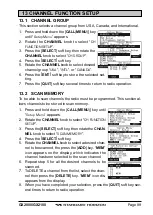
GX2000/GX2100
Page 102
15 AIS/COMPASS SETUP
15.1 AUTOMATIC IDENTIFICATION SYSTEM
(
AIS
)
NOTE
The MATRIX AIS
GX2100
does not require a special marine VHF an-
tenna to receive AIS transmissions. The MATRIX AIS
GX2100
does not
transmit AIS signals, it is NOT recommended to use an antenna dedi-
cated for AIS operation.
The Automatic Identification System (AIS) is a short range coastal tracking
system. AIS is intended to assist in collision avoidance by seeing positions
and courses of AIS equipped vessels around your vessel.
AIS is mandatory on passenger ships, irrespective of size, all ships 300 gross
tonnage and larger engaged on international voyages, cargo ships of 500 gross
tonnage and larger not engaged on international voyages.
AIS uses two marine VHF channels. Each ship equipped with an AIS tran-
sponder transmits a packet every few seconds with information about the ship
and its voyage. Radio frequencies: AIS1 = 161.975 MHz, or channel 87B and
AIS2 162.025 MHz , or channel 88B. A stand-alone AIS receiver or the AIS
receiver built in to a Class A or Class B transponder can pick up these radio
signals and translate them into a NMEA data sentence that can be understood
by a computer with the proper software or by an AIS-enabled chart plotter.
Classes of AIS:
Class A - 12.5W power output - mandated for use on SOLAS Chapter V ves-
sels (and others in some countries).
Class B - 2W output - lower cost derivative for leisure and non-SOLAS markets.
The MATRIX AIS
GX2100
is capable of receiving Class A and B transmission
with the internal Dual Channel AIS receiver. The
GX2000
must be connected
to an optional AIS receiver or transponder.
What is the range for AIS receivers?
Since AIS uses similar VHF frequencies as a marine VHF radio, it has
similar radio reception capabilities - which are basically line of sight. This
means the higher your VHF antenna is mounted, the greater the reception
area will be.
Reception from Class A vessels that are 20 or even 30 miles away on open
water is not uncommon as their antennas are mounted high off the water.
Class B transponders use lower power for transmissions, therefore you can
expect Class B vessels to be received when they are 5 to 10 miles away.
For additional information on AIS visit the USCG web site: <http://
www.navcen.uscg.gov/marcomms/ais.htm>
Summary of Contents for GX2000
Page 113: ...Page 113 GX2000 GX2100 MEMO ...
Page 133: ...Page 133 GX2000 GX2100 MEMO ...
Page 134: ...GX2000 GX2100 Page 134 MEMO ...
















































